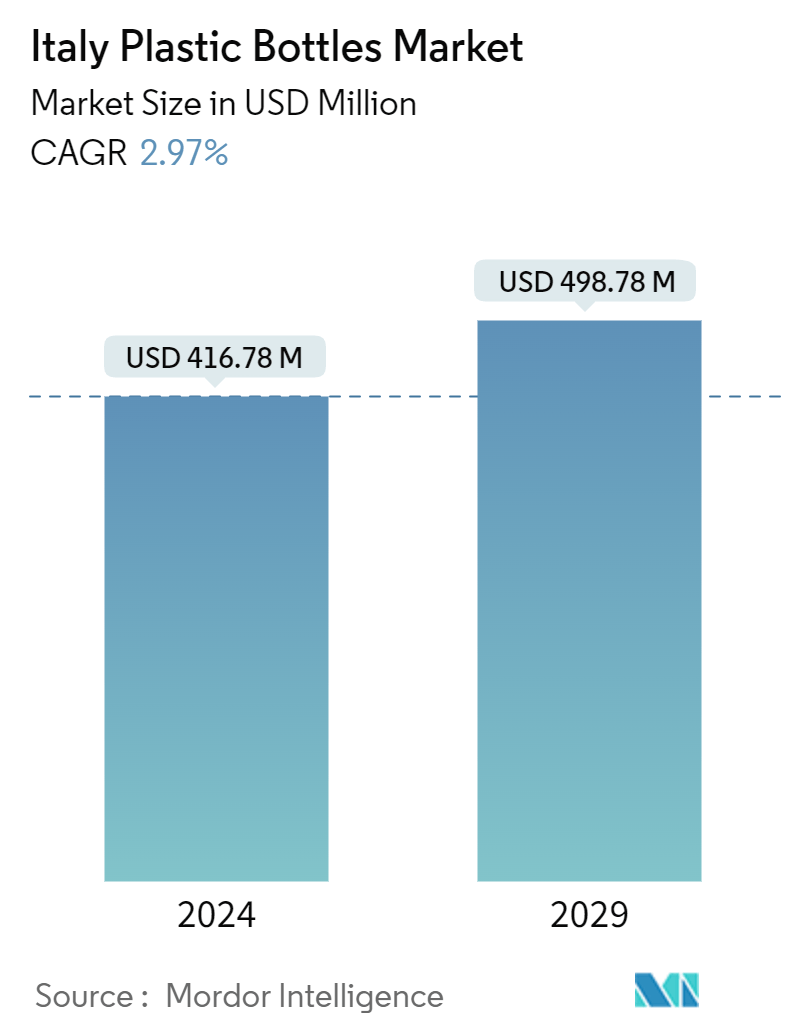Market Size of Italy Plastic Bottles Industry

| Study Period | 2019 - 2029 |
| Base Year For Estimation | 2023 |
| Market Size (2024) | USD 416.78 Million |
| Market Size (2029) | USD 498.78 Million |
| CAGR (2024 - 2029) | 2.97 % |
| Market Concentration | Medium |
Major Players
*Disclaimer: Major Players sorted in no particular order |
Italy Plastic Bottles Market Analysis
The Italy Plastic Bottles Market size is estimated at USD 416.78 million in 2024, and is expected to reach USD 498.78 million by 2029, growing at a CAGR of 2.97% during the forecast period (2024-2029). In terms of production capacity, the market is expected to grow from 451.24 thousand tonnes in 2024 to 518.40 thousand tonnes by 2029, at a CAGR of 2.81% during the forecast period (2024-2029).
- Plastic bottles made from PP, PET, and HDPE are commonly used for various applications, including pharmaceutical, food and beverage, cosmetics, household, and chemical packaging. These materials offer durability, safety, and recyclability. Over the past few years, the Italian plastic bottles market has experienced notable growth, influenced by various production and consumption factors. While Italy's renowned food and beverage industry, especially its wine and olive oil sectors, traditionally favored glass, the cost-effectiveness and durability of plastic bottles have led to their rising popularity. The convenience of plastic bottles, particularly for non-alcoholic beverages like water and soft drinks, has solidified their position in Italy, where consumers prioritize portability and lightweight packaging.
- Key drivers in the Italian plastic bottles market include the surging demand for bottled water, largely fueled by the nation's vibrant tourism sector. Moreover, the fast-paced lifestyles of Italians are steering them toward a preference for ready-to-drink products in plastic packaging. The growing inclination toward healthier, on-the-go beverages, such as functional drinks and natural juices, further boosts the demand for plastic bottles, especially in smaller, single-use sizes tailored for individual consumption.
- Current trends in the Italian plastic bottles market exhibit a broader global shift toward sustainability. In response to the Italian government's regulations aimed at curbing plastic waste, manufacturers are increasingly turning to eco-friendly alternatives and bolstering recycling infrastructures. A significant movement toward recycled PET (rPET) in bottle production is evident, spurred by legislative mandates and consumer demand for eco-conscious products. This shift is further reinforced by a growing awareness among Italians regarding the environmental ramifications of plastic waste, fostering a preference for brands prioritizing sustainability.
- For instance, in September 2023, Italian PET recycler Dentis Recycling, based in Piedmont, unveiled its new food-grade rPET brand. With the addition of two Starlinger Recostar PET bottle-to-bottle recycling lines, Dentis expanded its offerings to include food-grade rPET pellets alongside hot-washed PET bottle flakes. Marketed under the brand name "Repeter," these pellets, produced on Starlinger's advanced lines, come in various colors. Notably, the Starlinger PET recycling process has garnered positive endorsements from the European Food Safety Authority (EFSA) and Letters of No Objection (LNOs) from the US Food and Drug Administration (FDA). Furthermore, Dentis has secured approvals for its food-grade rPET pellets from several major food packaging brand owners and supplies these pellets to prominent players in the food and beverage sector and local plastic packaging manufacturers.
- Material innovations are pivotal in shaping Italy's plastic bottles landscape. There's a growing momentum behind biodegradable and bio-based plastics as companies strive to shrink their carbon footprints. Furthermore, the trajectory of Italy's plastic bottle market is expected to be influenced by a blend of regulatory frameworks, shifting consumer preferences, and technological breakthroughs. As Italy aligns more closely with European Union directives on plastic reduction, a gradual pivot toward sustainable practices, especially recycling, is anticipated. The industry faces the challenge of harmonizing these environmental aspirations with the economic realities of manufacturers and the practical needs of consumers, ensuring responsiveness to both global trends and local nuances.

